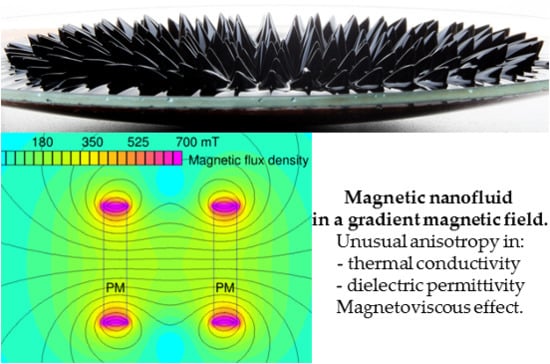Magnetic Field Effect on Thermal, Dielectric, and Viscous Properties of a Transformer Oil-Based Magnetic Nanofluid †
Abstract
1. Introduction
2. Materials and Methods
3. Results and Discussion
3.1. Thermal Conductivity
3.2. Dielectric Permittivity
3.3. Viscosity
4. Conclusions
Author Contributions
Funding
Acknowledgments
Conflicts of Interest
References
- Fofana, I. 50 years in the development of insulating liquids. IEEE Electr. Insul. Mag. 2013, 29, 13–25. [Google Scholar] [CrossRef]
- Wang, X.; Tang, C.; Huang, B.; Hao, J.; Chen, G. Review of research progress on the electrical properties and modification of mineral insulating oils used in power transformers. Energies 2018, 11, 487. [Google Scholar] [CrossRef]
- Bhunia, M.M.; Panigrahi, K.; Das, S.; Chattopadhyay, K.K.; Chattopadhyay, P. Amorphous graphene—Transformer oil nanofluids with superior thermal and insulating properties. Carbon 2018, 139, 1010–1019. [Google Scholar] [CrossRef]
- Sen Gupta, S.; Manoj Siva, V.; Krishnan, S.; Sreeprasad, T.S.; Singh, P.K.; Pradeep, T.; Das, S.K. Thermal conductivity enhancement of nanofluids containing graphene nanosheets. J. Appl. Phys. 2011, 110, 084302. [Google Scholar] [CrossRef]
- Chen, J.; Sun, P.; Sima, W.; Shao, Q.; Ye, L.; Li, C. A promising nano-insulating-oil for industrial application: Electrical properties and modification mechanism. Nanomaterials 2019, 9, 788. [Google Scholar] [CrossRef] [PubMed]
- Pislaru-Danescu, L.; Morega, A.M.; Telipan, G.; Morega, M.; Dumitru, J.B.; Marinescu, V. Magnetic nanofluid applications in electrical engineering. IEEE Trans. Magn. 2013, 49, 5489–5497. [Google Scholar] [CrossRef]
- Rajnak, M.; Timko, M.; Kopcansky, P.; Paulovicova, K.; Kuchta, J.; Franko, M.; Kurimsky, J.; Dolnik, B.; Cimbala, R. Transformer oil-based magnetic nanofluid with high dielectric losses tested for cooling of a model transformer. IEEE Trans. Dielectr. Electr. Insul. 2019, 26, 1343–1349. [Google Scholar] [CrossRef]
- Nkurikiyimfura, I.; Wang, Y.; Pan, Z. Heat transfer enhancement by magnetic nanofluids—A review. Renew. Sustain. Energy Rev. 2013, 21, 548–561. [Google Scholar] [CrossRef]
- Lee, M.; Kim, Y.-J. Thermomagnetic Convection of Ferrofluid in an Enclosure Channel with an Internal Magnetic Field. Micromachines 2019, 10, 553. [Google Scholar] [CrossRef]
- Vatani, A.; Woodfield, P.L.; Nguyen, N.T.; Dao, D.V. Onset of thermomagnetic convection around a vertically oriented hot-wire in ferrofluid. J. Magn. Magn. Mater. 2018, 456, 300–306. [Google Scholar] [CrossRef]
- Bianco, V.; Manca, O.; Nardini, S.; Vafai, K. Heat Transfer Enhancement with Nanofluids; CRC Press: Boca Raton, FL, USA, 2015; ISBN 1482254026. [Google Scholar]
- Doganay, S.; Alsangur, R.; Turgut, A. Effect of external magnetic field on thermal conductivity and viscosity of magnetic nanofluids: A review. Mater. Res. Express 2019, 6, 112003. [Google Scholar] [CrossRef]
- Patel, J.; Parekh, K.; Upadhyay, R.V. Maneuvering thermal conductivity of magnetic nanofluids by tunable magnetic fields. J. Appl. Phys. 2015, 117, 243906. [Google Scholar] [CrossRef]
- Philip, J.; Shima, P.D.; Raj, B. Enhancement of thermal conductivity in magnetite based nanofluid due to chainlike structures. Appl. Phys. Lett. 2007, 91, 203108. [Google Scholar]
- Shima, P.D.; Philip, J.; Raj, B. Magnetically controllable nanofluid with tunable thermal conductivity and viscosity. Appl. Phys. Lett. 2009, 95, 133112. [Google Scholar] [CrossRef]
- Altan, C.L.; Elkatmis, A.; Yüksel, M.; Aslan, N.; Bucak, S. Enhancement of thermal conductivity upon application of magnetic field to Fe3O4 nanofluids. J. Appl. Phys. 2011, 110, 093917. [Google Scholar]
- Parekh, K.; Lee, H.S. Magnetic field induced enhancement in thermal conductivity of magnetite nanofluid. J. Appl. Phys. 2010, 107, 09A310. [Google Scholar]
- Wu, Z.; Sundén, B. Convective heat transfer performance of aggregate-laden nanofluids. Int. J. Heat Mass Transf. 2016, 93, 1107–1115. [Google Scholar] [CrossRef]
- Odenbach, S. Colloidal Magnetic Fluids: Basics, Development and Application of Ferrofluids; Springer: Berlin, Germany, 2009; ISBN 9783540853862. [Google Scholar]
- Jin, J.; Song, D.; Geng, J.; Jing, D. Time-dependent scattering of incident light of various wavelengths in ferrofluids under external magnetic field. J. Magn. Magn. Mater. 2018, 447, 124–133. [Google Scholar] [CrossRef]
- Gavili, A.; Zabihi, F.; Isfahani, T.D.; Sabbaghzadeh, J. The thermal conductivity of water base ferrofluids under magnetic field. Exp. Therm. Fluid Sci. 2012, 41, 94–98. [Google Scholar] [CrossRef]
- Katiyar, A.; Dhar, P.; Nandi, T.; Das, S.K. Magnetic field induced augmented thermal conduction phenomenon in magneto-nanocolloids. J. Magn. Magn. Mater. 2016, 419, 588–599. [Google Scholar] [CrossRef]
- Li, Q.; Xuan, Y.; Wang, J. Experimental investigations on transport properties of magnetic fluids. Exp. Therm. Fluid Sci. 2005, 30, 109–116. [Google Scholar] [CrossRef]
- Segal, V.; Hjortsberg, A.; Rabinovich, A.; Nattrass, D.; Raj, K. AC (60 Hz) and impulse breakdown strength of a colloidal fluid based on transformer oil and magnetite nanoparticles. In Proceedings of the Conference Record of the 1998 IEEE International Symposium on Electrical Insulation (Cat. No.98CH36239), Arlington, VA, USA, 7–10 June 1998; Volume 2, pp. 619–622. [Google Scholar]
- Lee, J.-C.; Seo, H.-S.; Kim, Y.-J. The increased dielectric breakdown voltage of transformer oil-based nanofluids by an external magnetic field. Int. J. Therm. Sci. 2012, 62, 29–33. [Google Scholar] [CrossRef]
- Kurimský, J.; Rajňák, M.; Cimbala, R.; Rajnič, J.; Timko, M.; Kopčanský, P. Effect of magnetic nanoparticles on partial discharges in transformer oil. J. Magn. Magn. Mater. 2019, 496, 165923. [Google Scholar] [CrossRef]
- Kurimský, J.; Rajňák, M.; Bartko, P.; Paulovičová, K.; Cimbala, R.; Medved, D.; Džamová, M.; Timko, M.; Kopčanský, P. Experimental study of AC breakdown strength in ferrofluid during thermal aging. J. Magn. Magn. Mater. 2018, 465, 136–142. [Google Scholar] [CrossRef]
- Hwang, J.G.; Zahn, M.; O’Sullivan, F.M.; Pettersson, L.A.A.; Hjortstam, O.; Liu, R. Effects of nanoparticle charging on streamer development in transformer oil-based nanofluids. J. Appl. Phys. 2010, 107, 014310. [Google Scholar] [CrossRef]
- Rajnak, M.; Spitalsky, Z.; Dolnik, B.; Kurimsky, J.; Tomco, L.; Cimbala, R.; Kopcansky, P.; Timko, M. Toward Apparent Negative Permittivity Measurement in a Magnetic Nanofluid with Electrically Induced Clusters. Phys. Rev. Appl. 2019, 11, 024032. [Google Scholar] [CrossRef]
- Rajnak, M.; Kurimsky, J.; Dolnik, B.; Kopcansky, P.; Tomasovicova, N.; Taculescu-Moaca, E.A.; Timko, M. Dielectric-spectroscopy approach to ferrofluid nanoparticle clustering induced by an external electric field. Phys. Rev. E 2014, 90, 032310. [Google Scholar] [CrossRef]
- Malaescu, I.; Marin, C.N. Dependence on the temperature of the activation energy in the dielectric relaxation processes for ferrofluids in low-frequency field. J. Magn. Magn. Mater. 2002, 252, 68–70. [Google Scholar] [CrossRef]
- Spanoudaki, A.; Pelster, R. Frequency dependence of dielectric anisotropy in ferrofluids. J. Magn. Magn. Mater. 2002, 252, 71–73. [Google Scholar] [CrossRef]
- Shahrivar, K.; Morillas, J.R.; Luengo, Y.; Gavilan, H.; Morales, P.; Bierwisch, C.; de Vicente, J. Rheological behavior of magnetic colloids in the borderline between ferrofluids and magnetorheological fluids. J. Rheol. 2019, 63, 547–558. [Google Scholar] [CrossRef]
- Rosa, A.P.; Cunha, F.R. The influence of dipolar particle interactions on the magnetization and the rotational viscosity of ferrofluids. Phys. Fluids 2019, 31, 052006. [Google Scholar] [CrossRef]
- Susan-Resiga, D.; Socoliuc, V.; Boros, T.; Borbáth, T.; Marinica, O.; Han, A.; Vékás, L. The influence of particle clustering on the rheological properties of highly concentrated magnetic nanofluids. J. Colloid Interface Sci. 2012, 373, 110–115. [Google Scholar] [CrossRef] [PubMed]
- Odenbach, S.; Pop, L.M.; Zubarev, A.Y. Rheological properties of magnetic fluids and their microstructural background. GAMM Mitt. 2007, 30, 195–204. [Google Scholar] [CrossRef]
- Shojaeizadeh, E.; Veysi, F.; Goudarzi, K.; Feyzi, M. Magnetoviscous effect investigation of water based Mn-ZnFe2O4 magnetic nanofluid under the influence of magnetic field: An experimental study. J. Magn. Magn. Mater. 2019, 477, 292–306. [Google Scholar] [CrossRef]
- Vékás, L.; Bica, D.; Avdeev, M.V. Magnetic nanoparticles and concentrated magnetic nanofluids: Synthesis, properties and some applications. China Particuol. 2007, 5, 43–49. [Google Scholar] [CrossRef]
- Rosensweig, R.E. Ferrohydrodynamics; Dover Publications: New York, NY, USA, 2013; ISBN 0486783006. [Google Scholar]
- Prasher, R.; Evans, W.; Meakin, P.; Fish, J.; Phelan, P.; Keblinski, P. Effect of aggregation on thermal conduction in colloidal nanofluids. Appl. Phys. Lett. 2006, 89, 143119. [Google Scholar] [CrossRef]
- Evans, W.; Prasher, R.; Fish, J.; Meakin, P.; Phelan, P.; Keblinski, P. Effect of aggregation and interfacial thermal resistance on thermal conductivity of nanocomposites and colloidal nanofluids. Int. J. Heat Mass Transf. 2008, 51, 1431–1438. [Google Scholar] [CrossRef]
- Rajnak, M.; Dolnik, B.; Kurimsky, J.; Cimbala, R.; Kopcansky, P.; Timko, M. Electrode polarization and unusual magnetodielectric effect in a transformer oil-based magnetic nanofluid thin layer. J. Chem. Phys. 2017, 146, 014704. [Google Scholar] [CrossRef]
- Odenbach, S.; Thurm, S. Magnetoviscous Effects in Ferrofluids. In Ferrofluids; Springer: Berlin/Heidelberg, Germany, 2002; pp. 185–201. [Google Scholar]
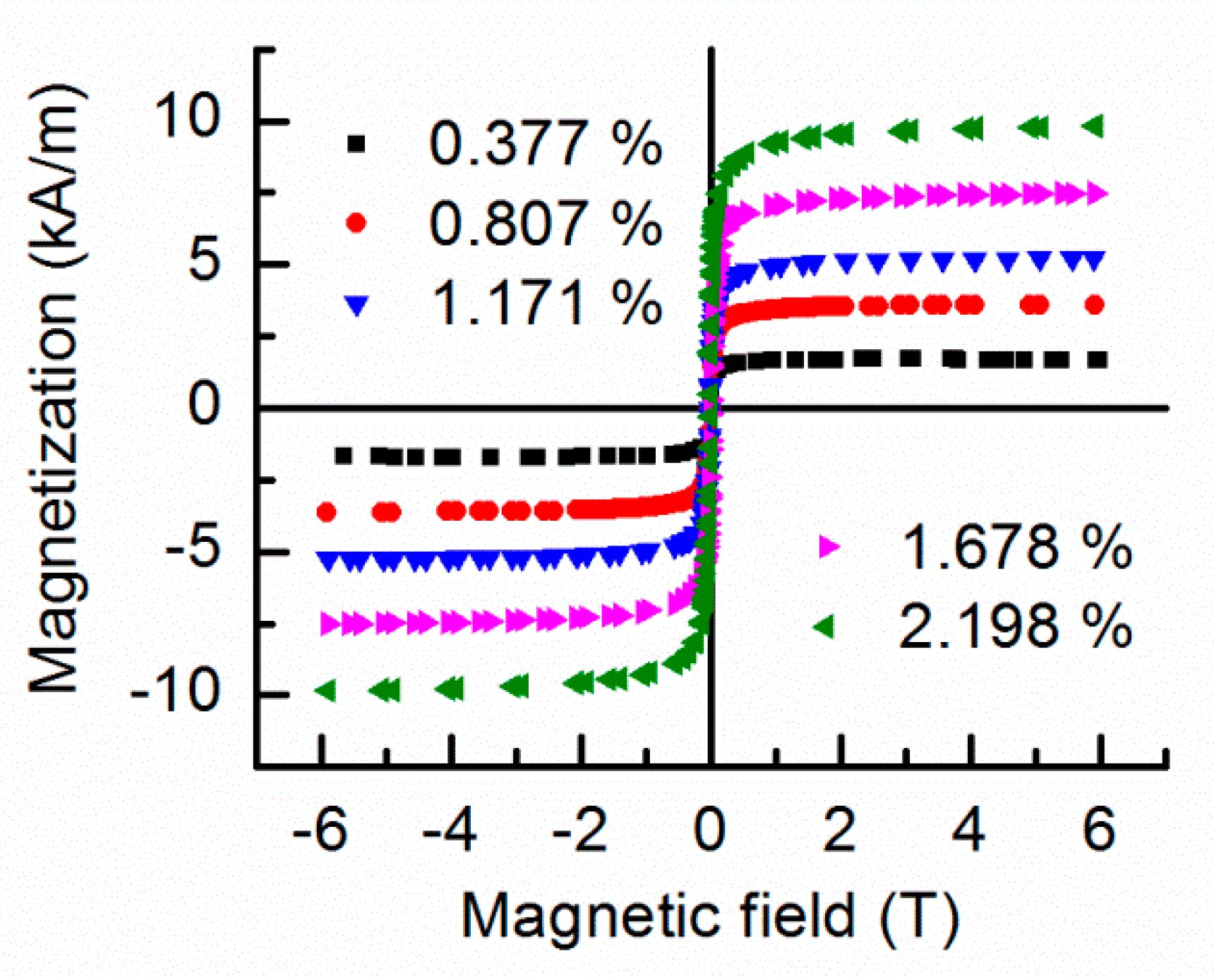
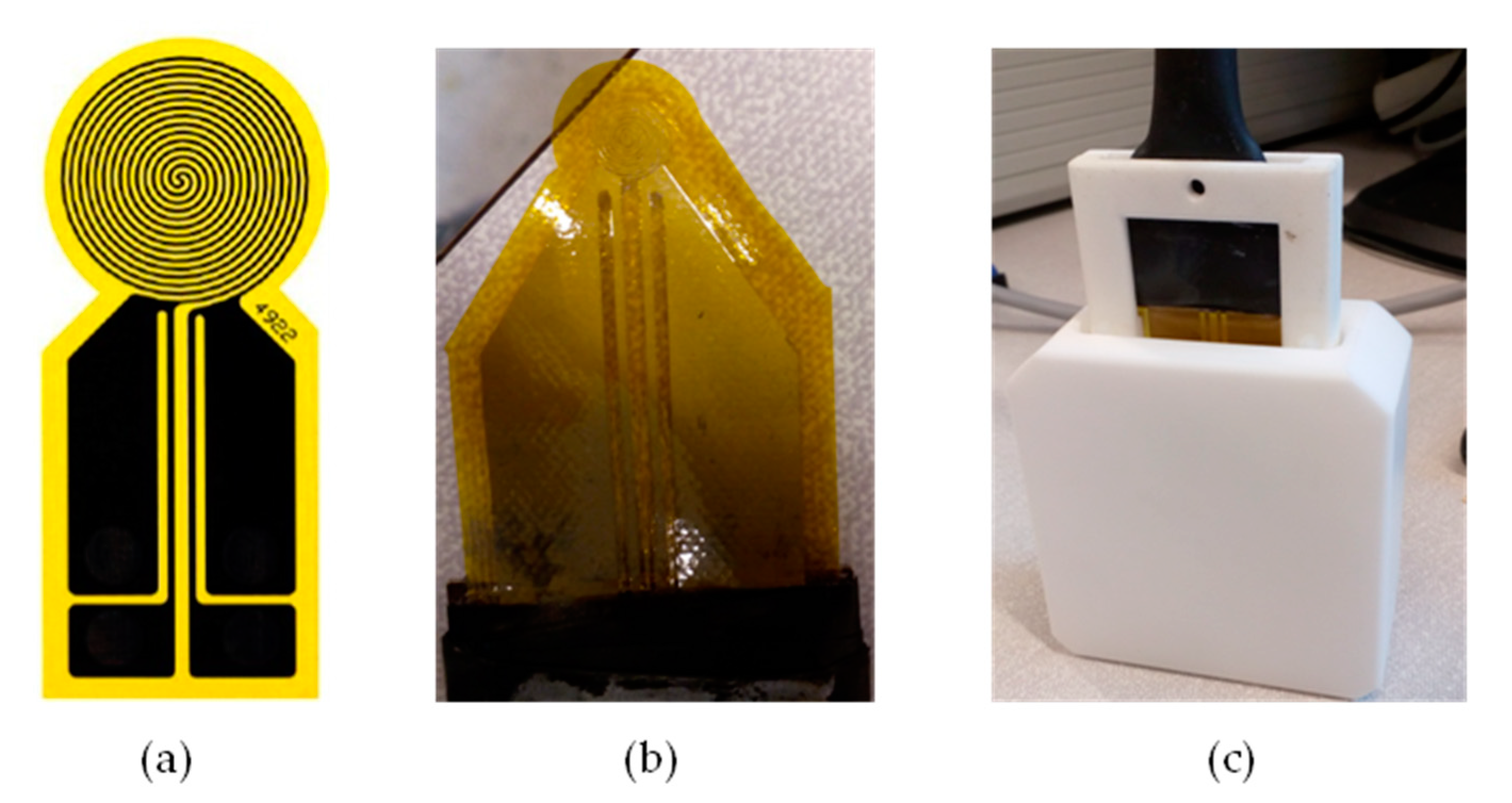
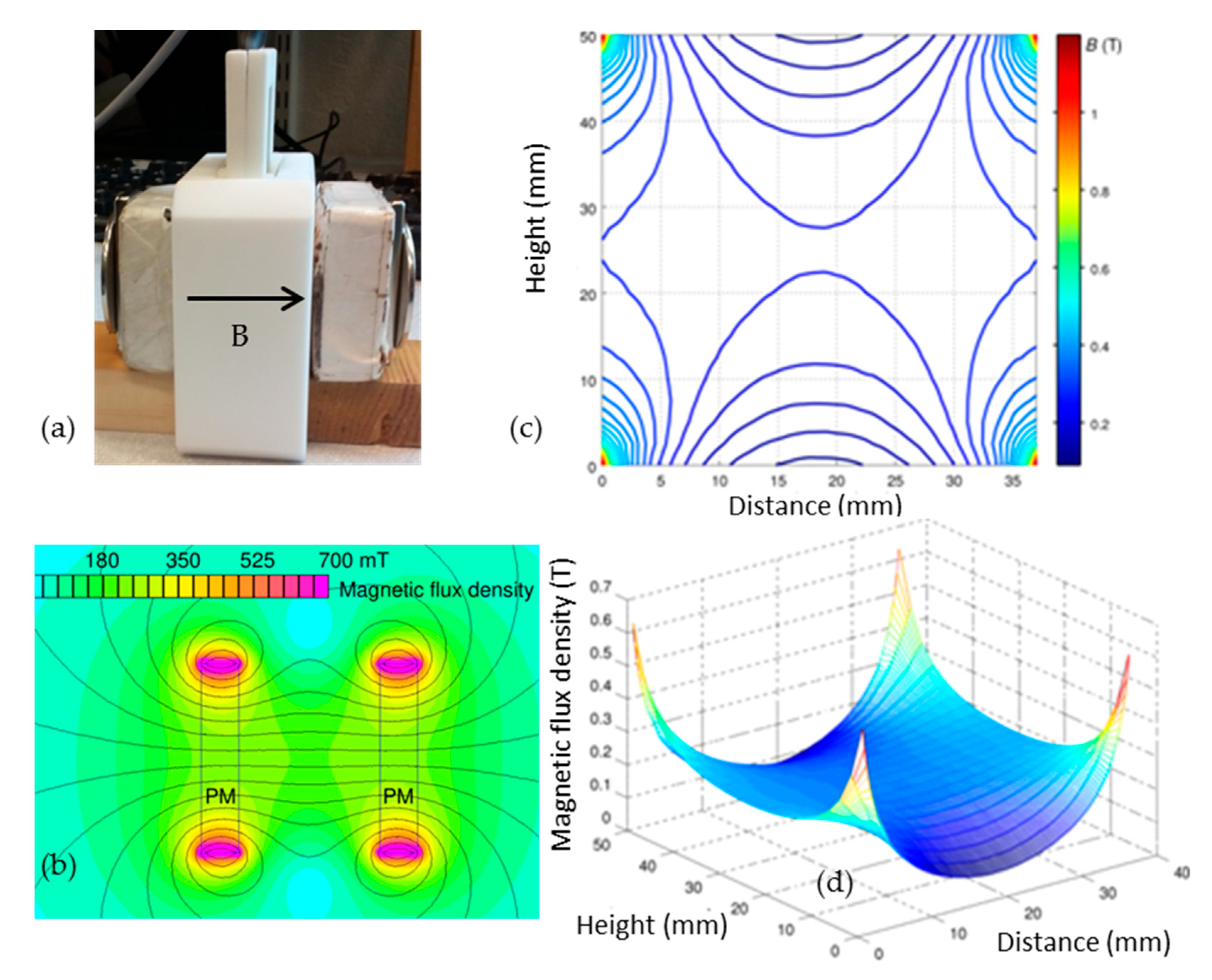
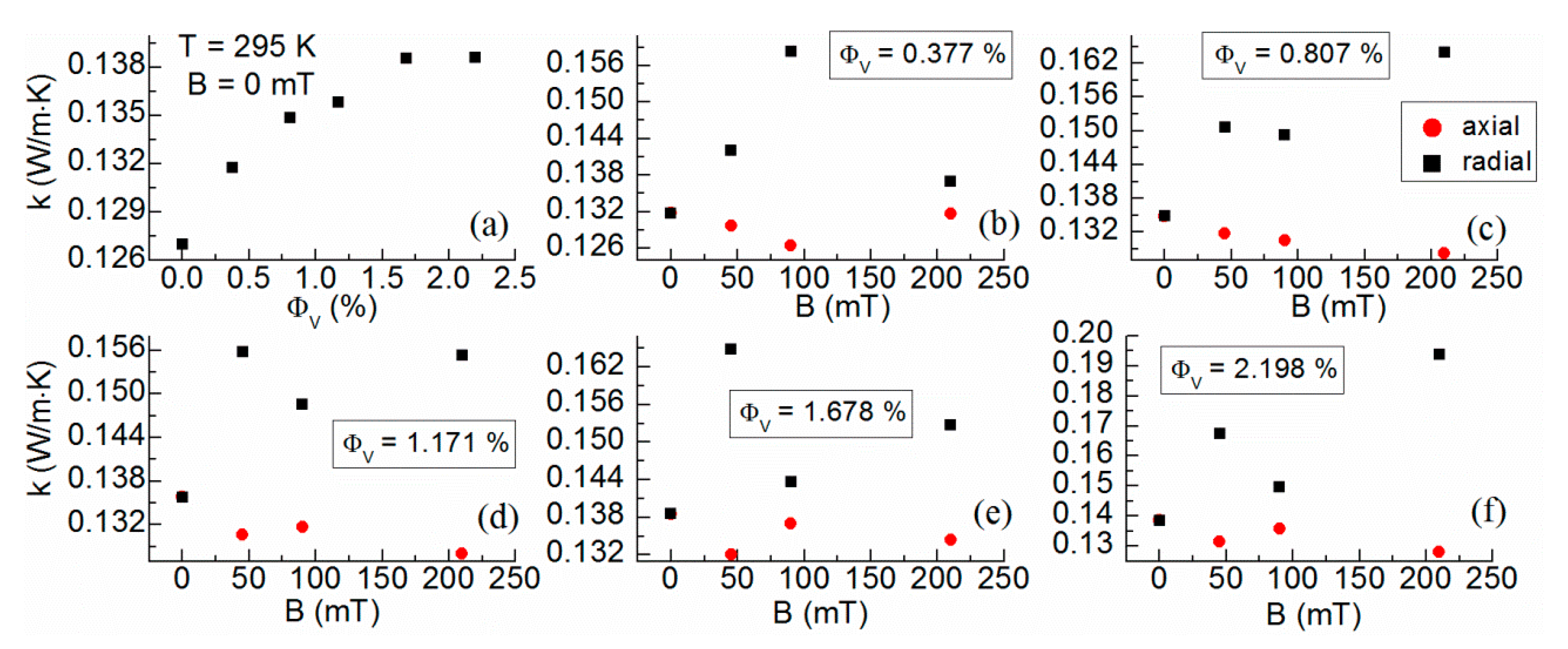
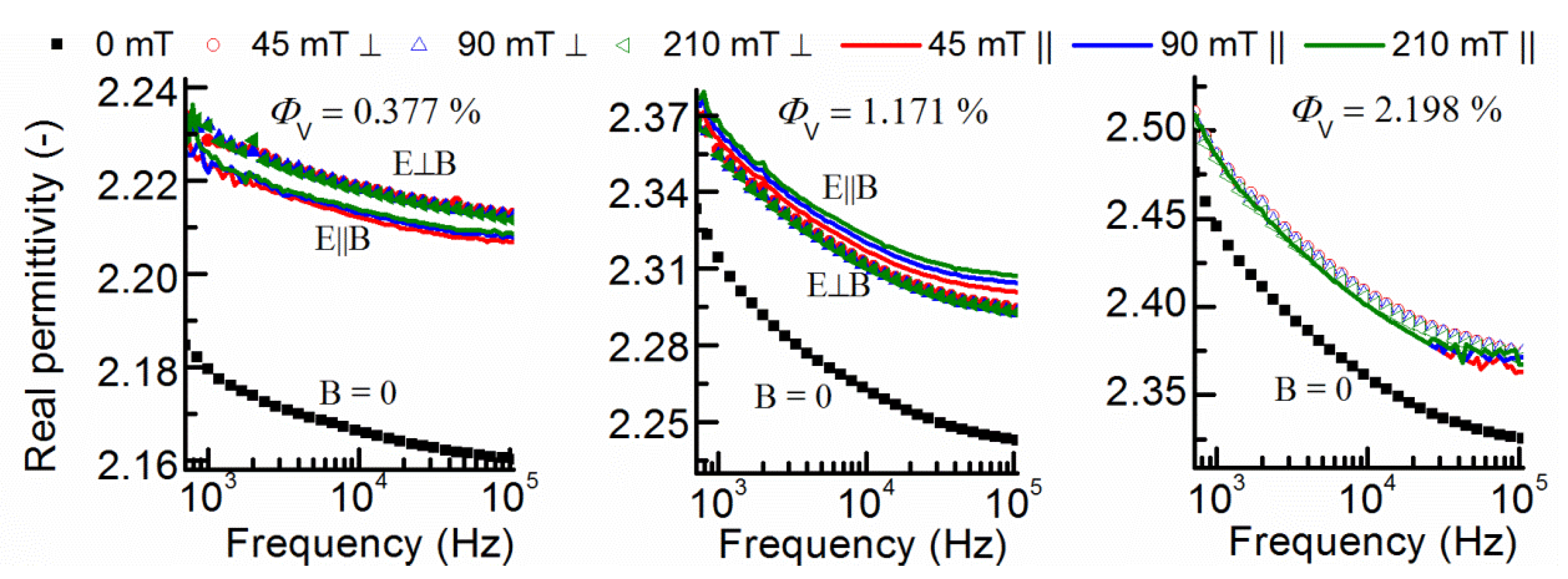

| Sample | Magnetization of Saturation (kA/m) | Magnetic Volume Fraction (%) | DC Magnetic Susceptibility (-) | Density (g/cm3) | Solid Volume Fraction (%) |
|---|---|---|---|---|---|
| MOL TO 40A | - | - | - | 0.867 | 0 |
| MNF_MOL 1 | 1.68 | 0.377 | 0.05 | 0.884 | 0.39 |
| MNF_MOL 2 | 3.598 | 0.807 | 0.11 | 0.909 | 0.97 |
| MNF_MOL 3 | 5.223 | 1.171 | 0.15 | 0.927 | 1.39 |
| MNF_MOL 4 | 7.469 | 1.675 | 0.21 | 0.95 | 1.92 |
| MNF_MOL 5 | 9.802 | 2.198 | 0.24 | 1.023 | 3.62 |
© 2019 by the authors. Licensee MDPI, Basel, Switzerland. This article is an open access article distributed under the terms and conditions of the Creative Commons Attribution (CC BY) license (http://creativecommons.org/licenses/by/4.0/).
Share and Cite
Rajnak, M.; Wu, Z.; Dolnik, B.; Paulovicova, K.; Tothova, J.; Cimbala, R.; Kurimský, J.; Kopcansky, P.; Sunden, B.; Wadsö, L.; et al. Magnetic Field Effect on Thermal, Dielectric, and Viscous Properties of a Transformer Oil-Based Magnetic Nanofluid. Energies 2019, 12, 4532. https://doi.org/10.3390/en12234532
Rajnak M, Wu Z, Dolnik B, Paulovicova K, Tothova J, Cimbala R, Kurimský J, Kopcansky P, Sunden B, Wadsö L, et al. Magnetic Field Effect on Thermal, Dielectric, and Viscous Properties of a Transformer Oil-Based Magnetic Nanofluid. Energies. 2019; 12(23):4532. https://doi.org/10.3390/en12234532
Chicago/Turabian StyleRajnak, Michal, Zan Wu, Bystrik Dolnik, Katarina Paulovicova, Jana Tothova, Roman Cimbala, Juraj Kurimský, Peter Kopcansky, Bengt Sunden, Lars Wadsö, and et al. 2019. "Magnetic Field Effect on Thermal, Dielectric, and Viscous Properties of a Transformer Oil-Based Magnetic Nanofluid" Energies 12, no. 23: 4532. https://doi.org/10.3390/en12234532
APA StyleRajnak, M., Wu, Z., Dolnik, B., Paulovicova, K., Tothova, J., Cimbala, R., Kurimský, J., Kopcansky, P., Sunden, B., Wadsö, L., & Timko, M. (2019). Magnetic Field Effect on Thermal, Dielectric, and Viscous Properties of a Transformer Oil-Based Magnetic Nanofluid. Energies, 12(23), 4532. https://doi.org/10.3390/en12234532







